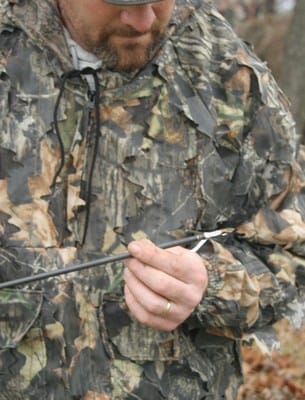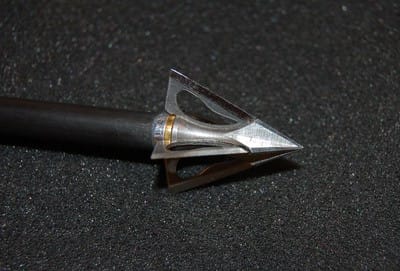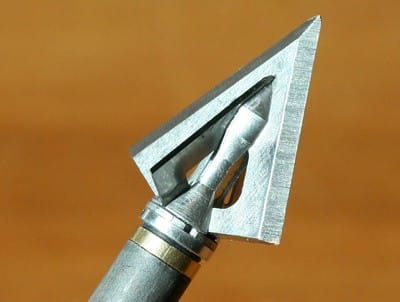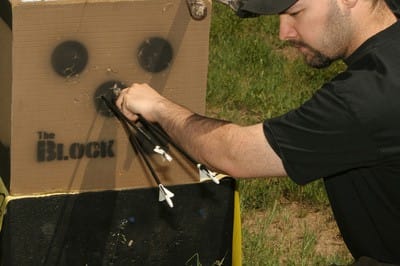
Choosing a new broadhead can be a daunting task. After all, there are more broadheads on the market than there are politicians in Washington D.C., so it is easy to get overwhelmed at the pro shop. When looking at new broadheads, the first thing you need to decide is which style of hunting you do most.
Expandable Broadheads
If you are a whitetail hunter, a variety of broadheads will work. One of the fastest growing segments of the broadhead market is expandable broadheads because they often fly like field tips and have large cutting diameters that bring whitetails down very fast. In the past, many bowhunters shied away from expandable broadheads largely because early models were prone to fail. The blades didn’t deploy properly on extreme angled shots or penetrate as well as fixed-blade broadheads. Most broadhead companies have worked out the kinks and most expandable broadheads are great options.
The pros of using expandable broadheads on whitetails are numerous. For me, the main advantage of expandable broadheads like Grim Reaper and the Rage have is large cutting diameters. If your shot isn’t perfect, the extra wide cutting diameter is still likely to bring the animal down. I have interviewed many bowhunters in recent years that use large cutting diameter expandable broadheads who have made not-so-good shots on deer only to recover them because they believe the extra large broadhead cut enough tissue to bring down the deer. If you decide to hunt with an expandable, purchase one that has a healthy cutting diameter but not so big that it reduces penetration. Look for one that has a cut-on-contact tip since this will help increase penetration. Using an expandable is a great option for whitetails if you buy a good one, but do lots of research before making a purchase.
Replaceable Blade Broadheads
Replaceable blade broadheads are still popular with many hunters.They are very popular because the blades are razor sharp and easy to replace. Over the years, many replaceable blade designs have hit the market, but one of my favorite designs is broadheads that have a cut-on-contact tip. G5, Wac’em and others have replaceable blade broadheads that have a super sharp tip. The blades slide in under the tip and they can be resharpened and the blades can be replaced.

These cut-on-contact replaceable blade models are becoming very popular in the West. The companies I discussed above offer these broadheads in a compact size. In most cases, they have a cutting diameter of an inch or so which creates a large enough hole to get the job done. At the same time, the heads are short and compact, which makes them accurate at long ranges even when they are shot out of today’s super fast bows. If you are a Western hunter who shoots at 50 yards or more, these broadheads are a great option because large broadheads often plane and are inaccurate at long ranges.
Fixed Blade Broadheads
Fixed-blade broadheads were the first broadheads on the market decades ago and many bowhunters still enjoy using them. The biggest advantage of using a fixed-blade broadhead is the fact that they are nothing but blade from tip to the stern. There aren’t any chisel points or blades that can come loose or not open. The fixed-blade broadhead is the simplest broadhead on the market.
The fixed-blade broadhead can be resharpened and reused. Some bowhunters actually sharpen them right out of the package which ensures their broadheads are as sharp as they can be at the moment of truth.

Many companies are now making compact fixed-blade broadheads. The Steel Force Phat Head and the G5 Montec are a couple examples. These compact models fly great and are super penetrators. For that reason, many bowhunters have started using compact fixed-blade broadheads. They are very accurate, very deadly, and you never have to worry about if they will work or not.
Even though penetration was mentioned in this article, it isn’t as big of a problem as it once was. Every broadhead company out there talks about how their broadhead out penetrates the competition, but the truth is most of today’s bows produce so much speed and kinetic energy that almost every broadhead out there has the qualities needed to blow through almost any size animal.

When choosing a broadhead, you need to ask yourself what you are looking for in a broadhead. Big-game animals like moose and elk have thicker skin than whitetails and many hunters choose a fixed-blade or replaceable-blade broadhead because they are more comfortable using them on animals with thick skin and heavy bones. Some bowhunters prefer heavy broadheads when hunting big game like moose or elk, so they use heavier broadheads that are 125 or 150 grains.
Each type of broadhead has its trade offs. The compact ones don’t have the cutting diameter of the expandables but the expandable broadheads can fail because they have moving parts. On every hunt I go on, I look at the critter I’ll be chasing and choose my broadhead accordingly. Almost every broadheads out there will perform perfectly every time, but I have been known to use a couple different models of broadhead in a single season because I think that one does a better job on a certain animal than another.
The broadhead you use depends on several factors. If possible, shoot a few different types before you purchase a lot of them. Whichever one flies the most accurately for you and feel the most comfortable with is the one you should shoot.



